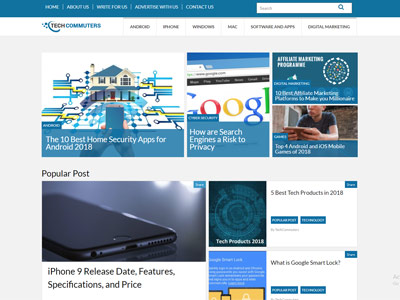Uncover Hidden Treasures in the Industry with the Best tech blog Recommendations
Wiki Article
Comprehending the Rise of Side Computing in Today's Digital World
In the rapidly progressing landscape of technology, edge computing arises as a crucial pressure, improving just how data is refined and made use of. By transitioning data monitoring closer to the source, side computing addresses vital latency concerns while enhancing transmission capacity use and boosting protection measures.What Is Edge Computer
Edge computer, although a fairly recent innovation in the world of technology, fundamentally changes how data is refined and managed by bringing calculation and data storage closer to the location where it is needed. Unlike conventional cloud computing versions, which often count on central data facilities that can be geographically remote, side computing decentralizes information handling. This proximity decreases latency, enhances real-time data handling, and improves the general customer experience by guaranteeing faster response times.At its core, side computer involves a network of local gadgets and facilities, such as entrances, routers, and sensors, efficient in processing information at or near the resource. This localized handling capability is particularly vital for applications calling for prompt data analysis, such as independent lorries, commercial automation, and wise cities. In addition, by offloading data handling jobs from main servers, edge computer lowers data transfer demands and boosts information privacy and security, as sensitive details can remain on-site as opposed to traversing substantial networks.

Key Chauffeurs of Fostering
Several factors are pushing the fostering of side computer in today's digital landscape. Side computing addresses this demand by making it possible for data handling closer to the data source, decreasing latency and improving real-time decision-making capabilities.Another substantial vehicle driver is the demand for enhanced bandwidth performance. Central cloud systems can end up being overloaded with the sheer quantity of information produced by IoT gadgets, bring about bottlenecks (Best tech blog). By processing data at the side, organizations can alleviate network congestion and boost overall system performance
Moreover, protection and personal privacy issues are pressing organizations toward edge computer. By processing delicate data in your area, companies can alleviate dangers related to data transmission and exposure to possible cyber threats.
The surge of applications requiring real-time processing, such as independent cars and increased reality, additionally demands the rapid feedback times that edge calculating provides. Jointly, these drivers are making side calculating an essential element of modern IT facilities, leading the method for its extensive fostering throughout numerous markets.
Benefits Over Cloud Computer
How does side computer identify itself from standard cloud computing? Mostly, edge computing brings information handling closer to the source of information generation, frequently on close-by web servers or local devices, rather than depending on central data centers. This proximity significantly minimizes latency, making it possible for real-time information processing and decision-making. For sectors where milliseconds matter, such as autonomous vehicles or commercial automation, the reduced latency provided by edge computing can be essential.Additionally, edge computer enhances bandwidth effectiveness (Best tech blog). By refining data locally, only the necessary information is transmitted to the cloud for additional evaluation or storage space, decreasing the volume of data that traverses the network. This not only alleviates network blockage however also decreases data transmission expenses
Edge computing additionally offers improved data privacy and protection. Delicate data can be processed locally without being sent to the cloud, lessening the exposure to potential cyber hazards. This is particularly beneficial for industries dealing with secret information, such as medical care and economic services.
In addition, side computer makes certain higher strength and integrity. Neighborhood processing permits proceeded operation even when connection to the cloud is endangered, maintaining vital features and solutions despite prospective network interruptions. These advantages collectively show edge computer's transformative capacity in maximizing performance and safety and security in electronic ecological communities.
Difficulties and Considerations
While side computer provides countless benefits, it also provides unique difficulties and factors to consider that should be addressed to totally understand its capacity. Additionally, handling and keeping an eye on a decentralized network of edge devices can be complex, needing advanced tools and techniques to ensure smooth procedure and upkeep. Best tech blog.One more consideration is the scalability of edge computer options. As the variety of connected devices grows, so does the need for refining power at the side, which can lead to source restrictions. Organizations should very carefully intend their infrastructure to fit this growth without compromising efficiency or effectiveness.
Interoperability is one more important variable. With numerous hardware and software program components included, guaranteeing compatibility and smooth integration can be challenging. Standardization initiatives are necessary to promote interaction between inconsonant systems.
Future Trends in Edge Computer
Expecting the future, side computer is positioned to revolutionize various sectors by making it possible for much faster data processing and decreasing latency. As the quantity of data generated by IoT tools continues to grow, edge computer will end up being progressively crucial in handling this increase successfully.An additional arising fad is the development of edge-native applications created specifically to take advantage of the special capabilities of side computing. These applications will certainly maximize efficiency and resource use, resulting in enhanced performance across numerous sectors. Innovations in 5G modern technology will certainly additionally boost side computer by supplying the necessary framework for high-speed, low-latency communication between tools and side nodes.
Conclusion
Side computer's increase is driven by the spreading of IoT gadgets and the demand for real-time data handling, which improves efficiency by lowering latency and decentralizing have a peek at these guys data administration. This strategy alleviates bandwidth inadequacies and protection issues, facilitating developments in applications like smart cities and self-governing vehicles. Regardless of obstacles such as infrastructure intricacy and integration, the future of edge computing guarantees a much more receptive electronic ecosystem, with proceeded technologies shaping its development and expanding its applicability across sectors.Edge computer, although a fairly recent development in the realm of innovation, basically transforms exactly how data is processed and handled by bringing computation and information storage space closer to the location where it is needed. Unlike traditional cloud computer versions, which commonly depend on centralized information centers that can try these out be geographically remote, edge computing decentralizes information handling. Furthermore, by unloading information handling jobs from central web servers, edge computing reduces bandwidth requirements and improves data personal privacy and security, as delicate details can remain on-site rather than passing through substantial networks.

Report this wiki page